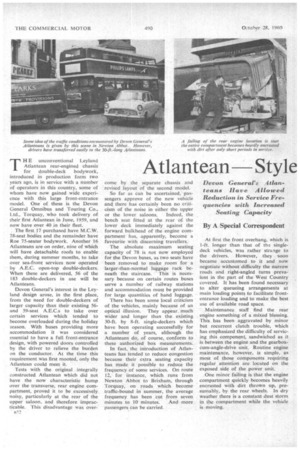Atlantean Style Pioneers
Page 66

Page 67

If you've noticed an error in this article please click here to report it so we can fix it.
Devon General's Atlanteans Have Allowed Reduction in Service Frequencies with Increased
Seating Capacity By A Special Correspondent
THE unconventional Leyland Atlantean rear-engined chassis for double-deck . bodywork, introduced in production form two years ago, is in service with a number of .operators in this country, some of whom have now gained wide experience with this large front-entrance model. One of these is the Devon General Omnibus and Touring Co., Ltd., Torquay, who took delivery of their first Atlantean in June. 1959, and now have over 40 in their fleet.
The first.17 purchased have. M.C.W. 78-seat bodies and the remainder have Roe 75-seater bodywork. Another 16 Atlanteans are on order, nine of which will have detachable roofs to enable them, during summer months, to take over sea-front services now operated by A.E.C. open-top double-deckers. When these are delivered, 56 of the 183 double-deckers in use will be Atlanteans.
Devon General's interest in the Leyland design arose, in the first place, from the need for double-deckers of larger capacity than their existing 56and 59-seat A.E.C.s to take over certain services which tended to become Overloaded during the holiday season. With buses providing more accommodation it was considered essential to have a full front-entrance design, with powered doors controlled by the driver 'to relieve the burden on the conductor. At the time this requirement was first mooted, only the Atlantean could meet it.
Tests with the original integrally constructed Atlantean which did not have the now characteristic hump over the transverse, rear engine compartment, proved it to be excessively noisy, particularly at the rear of the upper saloon, and therefore impracticable. This disadvantage was over all' come by the separate chassis and revised layout of the second model.
So far as can be ascertained, passengers approve of the new vehicle and there has certainly been no criticism of the noise in either the upper or the lower saloons. Indeed, the bench seat fitted at the rear "of the lower deck immediately against the forward bulkhead of the engine compartment has, apparently, become a favourite with discerning travellers.
The absolute maximum seating capacity of 78 is not now employed for the Devon buses, as two seats have been removed to make room for a larger-than-normal luggage rack .beneath the staircase. • This is necessary because on certain routes buses serve a number of railway stations and accommodation must be provided for large quantities of hand luggage.
There has been some local criticism of the vehicles, mainly because of an optical illusion. They appear, much wider and longer than the existing 30-ft. by 8-ft. single-deckers which have been operating successfully for a number of years, although the Atlanteans do, of course, conform to these authorized box measurements.
In fact, the introduction of Atlanteans has tended to reduce congestion because their extra seating capacity has made it possible to reduce the frequency of some services, On route 12, for instance, which runs from Newton Abbot to Brixham, through Torquay, on roads which become traffic-bound in summer, the average frequency has been cut from seven minutes to 10 minutes. And more passengers can be carried. At first the front overhang, which is 1-ft. longer than that of the singledeck vehicles, was rather strange to the drivers. However, they soon became accustomed to it and now negotiate without difficulty the narrow roads and right-angled turns prevalent in the part of the West Country covered. It has been found necessary to alter queueing arrangements at main loading points to facilitate frontentrance loading and to make the best use of available road space.
• Maintenance staff find the rear engine something of a mixed blessing. This has been aggravated by minor but recurrent clutch trouble, which has emphasized the difficulty of servicing this component, sandwiched as it is between the engine and the gearboxcum-angle-drive unit. Routine engine maintenance, however, is simple, as most of those components requiring regular attention are located on the exposed side of the power unit.
One minor failing is that the engine compartment quickly becomes heavily encrusted with dirt thrown up, presumably, by the rear wheels; In dry weather there is a constant dust storm in the compartment while the vehicle ismoving. Almost all chassis, as soon as they go into production and meet the rigorous test of constant operation. seem prone to teething troubles. Devon General's Atlanteans have been no exception to the rule, but the failings have now been largely overcome. Operationally, the Leyland vehicles have been most satisfactory, doing all that was expected of them and returning average fuel-consumption rates in the order of 9.5 m.p.g.
For most routes, the Leyland 0.600 9.8-litre 125-b.h.p. engine has proved adequate but it is considered that the vehicle might have been improved by the initial installation of the 11.1-litre 150-b.h.p. engine. To suit vehicles operating over a number of hilly services, Devon General are now experimenting with Sim ms-Eberspacher turbochargers.




















































































































